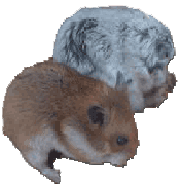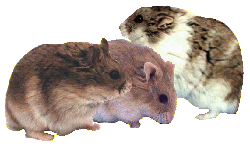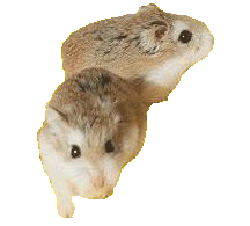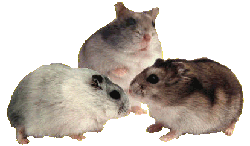









 The Syrian Hamster is the most popular of all
the hamster breeds with the scientific name
of "Mesocritus auratus". They are noctural
and lack odour of any kind, and spend a lot
of time on cleaning. Males tend to be easier
to tame than females. Syrian hamsters find
great fun in hoarding food in their cheek
pouches and digorging the contents. They can
be found in over 30 colour varieties (cream,
cinnamon,white sepia, honey, silver-blue,
blank, normal, light golden, chocolate, and
many more)and can be found in the color patterns piebalds, mosaics,
satinised, and tortiose shell. They may be 20 to 25cm long and weigh 100 to
150g. Syrian hamsters can live together four weeks from birth, thereafter
they must be housed separately. Syrian hamsters have a life span of about 2
years. .
The Syrian Hamster is the most popular of all
the hamster breeds with the scientific name
of "Mesocritus auratus". They are noctural
and lack odour of any kind, and spend a lot
of time on cleaning. Males tend to be easier
to tame than females. Syrian hamsters find
great fun in hoarding food in their cheek
pouches and digorging the contents. They can
be found in over 30 colour varieties (cream,
cinnamon,white sepia, honey, silver-blue,
blank, normal, light golden, chocolate, and
many more)and can be found in the color patterns piebalds, mosaics,
satinised, and tortiose shell. They may be 20 to 25cm long and weigh 100 to
150g. Syrian hamsters can live together four weeks from birth, thereafter
they must be housed separately. Syrian hamsters have a life span of about 2
years. .
Russian Dwarf Hamster
 The Dwarf Campbells Russian
Hamster originates from Central
Asia, Northern Russia, Mongolia
and North China where it lives in
sand dunes. It has been kept in
the UK since 1963 and was
introduced to the pet market in
the UK in the 1970s. The Dwarf
Campbells Russian Hamster
(sometimes known as the Djungarian Hamster and often incorrectly labelled
the Siberian Hamster in pet shops) is the more common than the other
sub-species of Dwarf Russian Hamster, the Dwarf Winter White Russian
(Siberian) Hamster, and is often seen in pet shops in many countries today.
The Dwarf Campbells Russian
Hamster originates from Central
Asia, Northern Russia, Mongolia
and North China where it lives in
sand dunes. It has been kept in
the UK since 1963 and was
introduced to the pet market in
the UK in the 1970s. The Dwarf
Campbells Russian Hamster
(sometimes known as the Djungarian Hamster and often incorrectly labelled
the Siberian Hamster in pet shops) is the more common than the other
sub-species of Dwarf Russian Hamster, the Dwarf Winter White Russian
(Siberian) Hamster, and is often seen in pet shops in many countries today.
The Dwarf Campbells Russian Hamster is approximately 10-12cm in length
when full grown, with males being larger than females. The Dwarf
Campbells Russian Hamster has a plump rounded body and expandable
cheekpouches wihch they do not use as much as the Syrian. They sometimes
give of an oil similar to that smelt on ducks. They are sociable so can live in
groups if introduced young. The Dwarf Campbells Russian Hamster is
nocturnal but can be quite active for short periods during the day. It makes
a good pet for, but it should be avoided if you are buting this for a child.
The Russian Dwarf Hamster can also be less tolerant of clumsy handling
than the bigger Syrian Hamster and more prone to nip when annoyed. They
are able to squeeze through the bars of some hamster cages and so cages
designed for mice, glass or plastic aquariums make more suitable cages. The
average lifespan of the Dwarf Campbells Russian Hamster is 1-2 years.
Roborovski Dwarf Hamster
 The Roborovski is not widely kept
as a pet because it is not as easy
to handle as other species of
Dwarf Hamsters. The Roborovski
hamster is extremely lively and
very fast but they are of very
good temperament and rarely nip.
They are rarely seen in pet shops
but specialist hamster breeders
in many countries do keep the
Roborovski hamster. The
Roborovski is the smallest of the
hamsters kept as pets being only
around 4-5 cm in size. The Roborovski is golden-orange in colour with a
white belly and has distinctive white 'eyebrows' which make them very
appealing. Because they are hard to hol they are not reccomended for
children. They are able to squeeze through the bars of some of the hamster
cages and mice cages sold in pet shops and so are best kept in glass or
plastic tanks. The Roborovski Hamster is sociable and will live with others
of its own kind in single or mixed sex groups provided that hamsters are
introduced at a young age. The Roborovski Hamster is nocturnal but can be
quite active for short periods during the day. It is rather shy. They are able
to squeeze through the bars of some hamster cages, therefore glass or
plastic tamks are best. The average lifespan of the Roborovski Hamster is
3-3ö years
The Roborovski is not widely kept
as a pet because it is not as easy
to handle as other species of
Dwarf Hamsters. The Roborovski
hamster is extremely lively and
very fast but they are of very
good temperament and rarely nip.
They are rarely seen in pet shops
but specialist hamster breeders
in many countries do keep the
Roborovski hamster. The
Roborovski is the smallest of the
hamsters kept as pets being only
around 4-5 cm in size. The Roborovski is golden-orange in colour with a
white belly and has distinctive white 'eyebrows' which make them very
appealing. Because they are hard to hol they are not reccomended for
children. They are able to squeeze through the bars of some of the hamster
cages and mice cages sold in pet shops and so are best kept in glass or
plastic tanks. The Roborovski Hamster is sociable and will live with others
of its own kind in single or mixed sex groups provided that hamsters are
introduced at a young age. The Roborovski Hamster is nocturnal but can be
quite active for short periods during the day. It is rather shy. They are able
to squeeze through the bars of some hamster cages, therefore glass or
plastic tamks are best. The average lifespan of the Roborovski Hamster is
3-3ö years
Chinese Hamster
 The Chinese Hamster originates
from Northern China and
Mongolia and belongs to a group
known as Rat-like hamsters. The
Chinese hamster has been kept in
the UK since 1919 and was used
in laboratories. Interest in the Chinese as a pet grew in the 1970s when the
Russian hamster was introduced to the pet market. The Chinese Hamster is
not as widely kept as a pet as the Russian Hamsters and this is probably due
to their mouselike appearance and the fact that fewer numbers exist due to
some difficulties in breeding them. The Chinese Hamster has a slender
mouselike body which is approximately 10-12cm in length with males being
larger than females. The males have a large scrotal sac. The Chinese
Hamster has expandable cheekpouches. The Chinese Hamster is sociable
and will live with others of its own kind in single or mixed sex groups
provided that hamsters are introduced at a young age. However, within
breeding groups the females can become very aggressive towards the males
when pregnant and so it is important that they are housed in a large cage
with many hiding places where the males can seek refuge. The Chinese
Hamster is nocturnal but can be quite active for short periods during the
day. It is extremely timid and can be fast moving and they are very good
climbers. The Chinese Hamster makes a good pet although because it is fast
moving can be difficult to catch but once caught they are a pleasure to
handle. They are able to squeeze through the bars of some hamster cages
and so cages designed for mice, glass or plastic aquariums make more
suitable cages. The average lifespan of the Chinese Hamster is 2-3 years .
The Chinese Hamster originates
from Northern China and
Mongolia and belongs to a group
known as Rat-like hamsters. The
Chinese hamster has been kept in
the UK since 1919 and was used
in laboratories. Interest in the Chinese as a pet grew in the 1970s when the
Russian hamster was introduced to the pet market. The Chinese Hamster is
not as widely kept as a pet as the Russian Hamsters and this is probably due
to their mouselike appearance and the fact that fewer numbers exist due to
some difficulties in breeding them. The Chinese Hamster has a slender
mouselike body which is approximately 10-12cm in length with males being
larger than females. The males have a large scrotal sac. The Chinese
Hamster has expandable cheekpouches. The Chinese Hamster is sociable
and will live with others of its own kind in single or mixed sex groups
provided that hamsters are introduced at a young age. However, within
breeding groups the females can become very aggressive towards the males
when pregnant and so it is important that they are housed in a large cage
with many hiding places where the males can seek refuge. The Chinese
Hamster is nocturnal but can be quite active for short periods during the
day. It is extremely timid and can be fast moving and they are very good
climbers. The Chinese Hamster makes a good pet although because it is fast
moving can be difficult to catch but once caught they are a pleasure to
handle. They are able to squeeze through the bars of some hamster cages
and so cages designed for mice, glass or plastic aquariums make more
suitable cages. The average lifespan of the Chinese Hamster is 2-3 years .
Winter White Russian (Siberian) Dwarf
 The Dwarf Winter White Russian
originates from Eastern
Kazakhastan and South West
Siberia where it lives amongst
grassy steppes. It was introduced
into the UK pet market in 1978
and can be found on the pet
market in other countries. The
Dwarf Winter White Russian
Hamster is the least common of the two sub-species of Dwarf Russian
Hamster kept as pets and is therefore rarely seen in pet shops. The Dwarf
Winter White Russian is sometimes also known as the Siberian Hamster. It
is more compact in shape than the Dwarf Campbells Russian Hamster and
has more prominent eyes, a roman nose and a curved spine giving it a bullet
shaped body. The Dwarf Winter White Russian Hamster is approximately
8-10cm in length when full grown with males being larger than females. It
has expandable cheekpouches. The Dwarf Winter White Russian is so called
because of its tendency to turn white in the winter. This is due to the
shorter daylight hours and the hamster's coat may become lighter or have
white patches or become almost completely white. Dwarf Winter White
Russian Hamsters do not normally breed when in their winter white coat.
The Dwarf Winter White Russian Hamster is sociable and will live with
others of its own kind in single or mixed sex groups provided that hamsters
are introduced at a young age. The Dwarf Winter White Russian Hamster is
nocturnal but can be quite active for short periods during the day. It makes
a good pet although because of its small size it can be difficult for small
children to handle. The Dwarf Winter White Russian Hamster can also be
less tolerant of clumsy handling than the bigger Syrian Hamster but is
generally nice natured. They are able to squeeze through the bars of some
hamster cages and so cages designed for mice, glass or plastic aquariums
make more suitable cages. The average lifespan of the Dwarf Winter White
Russian Hamster is 1ö-2 years.
The Dwarf Winter White Russian
originates from Eastern
Kazakhastan and South West
Siberia where it lives amongst
grassy steppes. It was introduced
into the UK pet market in 1978
and can be found on the pet
market in other countries. The
Dwarf Winter White Russian
Hamster is the least common of the two sub-species of Dwarf Russian
Hamster kept as pets and is therefore rarely seen in pet shops. The Dwarf
Winter White Russian is sometimes also known as the Siberian Hamster. It
is more compact in shape than the Dwarf Campbells Russian Hamster and
has more prominent eyes, a roman nose and a curved spine giving it a bullet
shaped body. The Dwarf Winter White Russian Hamster is approximately
8-10cm in length when full grown with males being larger than females. It
has expandable cheekpouches. The Dwarf Winter White Russian is so called
because of its tendency to turn white in the winter. This is due to the
shorter daylight hours and the hamster's coat may become lighter or have
white patches or become almost completely white. Dwarf Winter White
Russian Hamsters do not normally breed when in their winter white coat.
The Dwarf Winter White Russian Hamster is sociable and will live with
others of its own kind in single or mixed sex groups provided that hamsters
are introduced at a young age. The Dwarf Winter White Russian Hamster is
nocturnal but can be quite active for short periods during the day. It makes
a good pet although because of its small size it can be difficult for small
children to handle. The Dwarf Winter White Russian Hamster can also be
less tolerant of clumsy handling than the bigger Syrian Hamster but is
generally nice natured. They are able to squeeze through the bars of some
hamster cages and so cages designed for mice, glass or plastic aquariums
make more suitable cages. The average lifespan of the Dwarf Winter White
Russian Hamster is 1ö-2 years.
